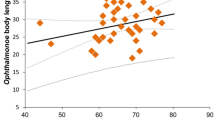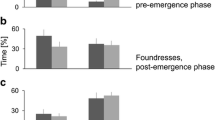Summary
This paper proposes and outlines a new interdiscipline, ‘behavioral parasitology,’ and presents some interpretations in one of the leading themes of this field, miracidial chemosensitivity to snails. Controversies over miracidial attraction and species-specificity are considered from the standpoints of the distinction between taxis and kinesis, the need for a stimulus gradient, and the possibility of an early phase in a miracidium's behavior adapted for dispersal rather than host-finding. Some of the many possible organic stimulants are discussed with regard to quantitative production by snails, sensory thresholds of the parasites, and possible interaction with inorganic ions. Organic and inorganic stimulants are considered to possibly from qualitative as well as quantitative gradients. A thermodynamic interpretation of miracidial klinokinesis as a function of stimulant concentration suggests the existence of two or more separate types of receptors for the same stimulant, one with a higher affinity for the stimulant and mediating a weaker klinokinesis (possibly a long-range receptor as compared to the other).
Similar content being viewed by others
References
Barlow, C.H.: The life cycle of the human intestinal flukeFasciolopsis buski (Lankester). Am. J. Hyg., Monogr. Ser.4, 1–98 (1925)
Barlow, C.H., Meleney, H.E.: A voluntary infection withSchistosoma haematobium. Am. J. Trop. Med.29, 79–87 (1949)
Beidler, L.M.: A theory of taste stimulation. J. Gen. Physiol.38, 133–139 (1954)
Cheng, T.C.: Marine molluscs as hosts for symbiosis, with a review of known parasites of commercially important species. In: Advances in marine biology, F.S. Russell, ed., Vol. 5, New York: Academic Press 1967
Chernin, E.: Behavioral responses of miracidia ofSchistosoma mansoni and other trematodes to substances emitted by snails. J. Parasitol.56, 287–296 (1970)
Chernin, E.: Some host-finding attributes ofSchistosoma mansoni miracidia. Am. J. Trop. Med. Hyg.23, 320–327 (1974)
Disko, R., Weber, L.: The attraction of miracidia ofSchistosoma mansoni to the snailBiomphalaria glabrata. Molluscs as intermediate hosts, Symposium of the German Society for Parasitology, Würzburg, 4–7 April 1979
Etges, F.J., Decker, C.L.: Chemosensitivity of the miracidium ofSchistosoma mansoni toAustralorbis glabratus and other snails. J. Parasitol.49, 114–116 (1963)
Faust, E.C.: The reactions of the miracidia ofSchistosoma japonicum andS. haematobium in the presence of their intermediate hosts. J. Parasitol.10, 199–204 (1924)
Leiper, R.T., Atkinson, E.L.: Observations on the spread of Asiatic schistosomiasis. Br. Med. J., January30, 201–203 (1915)
Lenhoff, H.M.: Some ionic, chemical, and endogenous factors affecting behavior of hydra. In: Chemistry of learning: invertebrate research, W.C. Corning and S.C. Ratner, eds., pp. 341–368. New York: Plenum Press 1967
Leuckart, K.G.F.R.: Die Parasiten des Menschen and die von ihnen herrührenden Krankheiten, Vol. I, Part 5, p. 264. Leipzig: C. F. Winter'sche Verlagshandlung 1894
MacInnis, A.J.: Responses ofSchistosoma mansoni miracidia to chemical attractants. J. Parasitol.51, 731–746 (1965)
MacInnis, A.J.: How parasites find hosts: some thoughts on the inception of host-parasite integration. In: Ecological aspects of parasitology, C.R. Kennedy ed., pp. 3–20. Amsterdam: North-Holland Publishing Co. 1976
MacInnis, A.J., Bethel, W.M., Cornford, E.M.: Identification of chemicals of snail origin that attractSchistosoma mansoni miracidia. Nature248, 361–363 (1974)
Mason, P.R.: Chemo-klino-kinesis in planarian food location. Anim. Behav.23, 460–469 (1975)
Mason, P.R., Fripp, P.J.: Analysis of the movements ofSchistosoma mansoni miracidia using dark-ground photography. J. Parasitol.62, 721–727 (1976)
Matovu D.B.: Reizphysiologische Untersuchungen zur Chemotaxis bei Cercarien (Trematoda, Digenea). Doctoral Dissertation, Universität Würzburg, Würzburg, Federal Republic of Germany 1971
Roberts, T.M., Ward, S., Chernin, E.: Behavioral responses ofSchistosoma mansoni miracidia in concentration gradients of snail-conditioned water. J. Parasitol.65, 41–49 (1979)
Saladin, K.S.: Behavioral manifestations of photosensitivity in cercariae ofSchistosoma mansoni (Digenea: Schistosomatidae). Ph. D. Dissertation, Florida State University, Tallahassee, Florida 1979
Saladin, K.S.: Host-finding by parasitic animals. In: Handbook series in nutrition and food, M. Rechcigl, ed. West Plam Beach, Florida: CRC Press (in preparation)
Salt, G.: Experimental studies in insect parasitism. III — host selection. Proc. R. Soc. Lond. [Biol]117, 413–435 (1935)
Sponholtz, G.M.: Stimulation and behavior of miracidia ofSchistosoma mansoni Ph. D. Dissertation, Florida State University, Tallahassee, Florida 1973
Sponholtz, G.M., Short, R.B.:Schistosoma mansoni miracidia: stimulation by calcium and magnesium. J. Parasitol.62, 155–157 (1976)
Stibbs, H.H., Chernin, E., Ward, S., Karnovsky, M.L.: Magnesium emitted by snails alters swimming behaviour ofSchistosoma mansoni miracidia. Nature260, 702–703 (1976)
Thomas, A.P.: The life history of the liver-fluke (Fasciola hepatica). Q. J. Microsc. Sci.23, 99–133 (1883)
Tinbergen, N.: On aims and methods of ethology. Z. Tierpsychol.20, 410–429 (1963)
Ullyett, G.C.: Host selection byMicroplectron fuscipennis, Zett. (Chalcididae, Hymenoptera), Proc. R. Soc. Lond. [Biol]120, 253–291 (1936)
Ulmer, M.J.: Site-finding behavior in helminths in intermediate and definitive hosts. In: Ecology and physiology of parasites, A.M. Fallis, ed., pp. 123–160. Toronto: University of Toronto Press 1971
Whittaker, R.H., Feeny, P.P.: Allelochemics: chemical interactions between species. Science171, 757–770 (1971)
Wilson, R.A., Dension, J.: Short chain fatty acids as stimulants of turning activity by the miracidium ofFasciola hepatica. Comp. Biochem. Physiol.32, 511–517 (1970)
Wright, C.A.: Host location by trematode miracidia. Ann. Trop. Med. Parasitol.53, 288–292 (1959)
Wright, D.G.S., Ronald, K.: Effect of amino acids and light on the behavior of miracidia ofSchistosomatium douthitti (Cort, 1914). Can. J. Zool.50, 855–860 (1972)
Author information
Authors and Affiliations
Rights and permissions
About this article
Cite this article
Saladin, K.S. Behavioral parasitology and perspectives on miracidial host-finding. Z. Parasitenkd. 60, 197–210 (1979). https://doi.org/10.1007/BF00929167
Received:
Issue Date:
DOI: https://doi.org/10.1007/BF00929167




